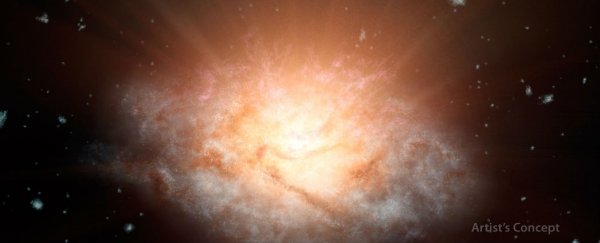NASA scientists have found the brightest-known galaxy in the Universe thanks to their hard working Wide-field Infrared Survey Explorer (WISE) space telescope.
WISE has been assisting scientists in compiling infrared images of the cosmos since 2009, and over the course of its mission, has discovered a whole new class of objects - extremely luminous infrared galaxies, otherwise known as ELIRGs. These are some of the most luminous systems in the Universe.
In a new report published this week in The Astrophysical Journal, an international team of astronomers has described 20 such ELIRGs, including one that dazzles brighter than any found before. Given the rather oblique name of WISE J224607.57-052635.0, this galaxy must have a ridiculously massive black hole in its belly, the team suggests.
"We are looking at a very intense phase of galaxy evolution," said the report's lead author Chao-Wei Tsai in a press statement. "This dazzling light may be from the main growth spurt of the galaxy's black hole."
Galaxies often have supermassive black holes in their cores. They draw gas and matter into a spinning disk around them, and it heats to millions of degrees, radiating super-bright light of various types. However, this light is blocked by dust, which then emits infrared light as it heats up. And this infrared radiance is what WISE has been detecting.
What's not yet clear is why the black holes powering ELIRGs are as big as they are. The researchers outline three possible causes in their report. It could be that the black holes simply started out bigger than we thought possible, or perhaps these supermassive black holes have been gobbling on gas faster than we thought was theoretically possible, bending or even breaking a principle called the Eddington limit.
According to this limit, a black hole can only devour so much matter before the light it blasts out pushes the 'food' out of reach. But if the limit is broken, a black hole could balloon like crazy in no time. "Another way for a black hole to grow this big is for it to have gone on a sustained binge, consuming food faster than typically thought possible," said Tsai in the press statement. "This can happen if the black hole isn't spinning that fast."
Or, the black holes in ELIRGs could be eating up more matter over a longer period of time. "It's like winning a hot-dog-eating contest lasting hundreds of millions of years," as the study's co-author, Andrew Blain, puts it.
Astronomers are now setting out to do more research on these shiny galaxies to determine the masses of their black holes, thus unravelling more knowledge about their history.
